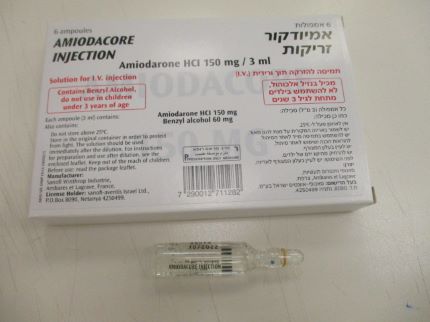Quest for the right Drug

אמיודקור זריקות AMIODACORE INJECTION (AMIODARONE HYDROCHLORIDE)
תרופה במרשם
תרופה בסל
נרקוטיקה
ציטוטוקסיקה
צורת מתן:
תוך-ורידי : I.V
צורת מינון:
תמיסה להזרקה : SOLUTION FOR INJECTION
עלון לרופא
מינוניםPosology התוויות
Indications תופעות לוואי
Adverse reactions התוויות נגד
Contraindications אינטראקציות
Interactions מינון יתר
Overdose הריון/הנקה
Pregnancy & Lactation אוכלוסיות מיוחדות
Special populations תכונות פרמקולוגיות
Pharmacological properties מידע רוקחי
Pharmaceutical particulars אזהרת שימוש
Special Warning עלון לרופא
Physicians Leaflet
Pharmacological properties : תכונות פרמקולוגיות
Pharmacodynamic Properties
5.1 Pharmacodynamic properties Amiodacore Injection is a product for the treatment of tachyarrhythmias and has complex pharmacological actions. Its effects are anti-adrenergic (partial alpha and beta blocker). It has haemodynamic effects (increased blood flow and systemic/coronary vasodilation). The drug reduces myocardial oxygen consumption and has been shown to have a sparing effect of rat myocardial ATP utilisation, with decreased oxidative processes. Amiodarone inhibits the metabolic and biochemical effects of catecholamines on the heart and inhibits Na+ and K+ activated ATPase. No controlled paediatric studies have been undertaken. In published studies the safety of amiodarone was evaluated in 1118 paediatric patients with various arrhythmias. The following doses were used in paediatric clinical trials. Oral - Loading dose: 10 to 20 mg/kg/day for 7 to 10 days (or 500 mg/m2/day if expressed per square meter). - Maintenance dose: the minimum effective dosage should be used; according to individual response, it may range between 5 to 10 mg/kg/day (or 250 mg/m2/day if expressed per square meter). Intravenous - Loading dose: 5 mg/kg body weight over 20 minutes to 2 hours. - Maintenance dose: 10 to 15 mg/kg/day from few hours to several days. If needed, oral therapy may be initiated concomitantly at the usual loading dose.
Pharmacokinetic Properties
5.2 Pharmacokinetic properties Amiodarone is metabolised mainly by CYP3A4, and also by CYP2C8, however the pharmacokinetics of amiodarone are unusual and complex, and have not been completely elucidated. Absorption following oral administration is variable and may be prolonged, with enterohepatic cycling. The major metabolite is desethylamiodarone. Amiodarone is highly protein bound (> 95%). Renal excretion is minimal and faecal excretion is the major route. A study in both healthy volunteers and patients after intravenous administration of amiodarone reported that the calculated volumes of distribution and total blood clearance using a two-compartment open model were similar for both groups. Elimination of amiodarone after intravenous injection appeared to be biexponential with a distribution phase lasting about 4 hours. The very high volume of distribution combined with a relatively low apparent volume for the central compartment suggests extensive tissue distribution. A bolus IV injection of 400mg gave a terminal T½ of approximately 11 hours. Amiodarone and its metabolite, desethylamiodarone, exhibit a potential in vitro to inhibit CYP1A1, CYP1A2, CYP2C9, CYP2C19, CYP2D6, CYP3A4, CYP2A6, CYP2B6 and CYP 2C8. Amiodarone and desethylamiodarone have also a potential to inhibit some transporters such as P-gp and organic cation transporter (OCT2) ( One study shows a 1.1% increase in concentration of creatinine (an OCT 2 substrate). In vivo data describe amiodarone interactions on CYP3A4, CYP2C9, CYP2D6 and P-gp substrates. No controlled paediatric studies have been undertaken. In the limited published data available in paediatric patients, there were no differences noted compared to adults.

שימוש לפי פנקס קופ''ח כללית 1994
Ventricular & supraventricular arrhythmias not responding to other treatments, tachyarrhythmias associated with Wolff-Parkinson-White syndrome
תאריך הכללה מקורי בסל
01/01/1995
הגבלות
תרופה מוגבלת לשימוש בבתי חולים או אשפוז יום
מידע נוסף
